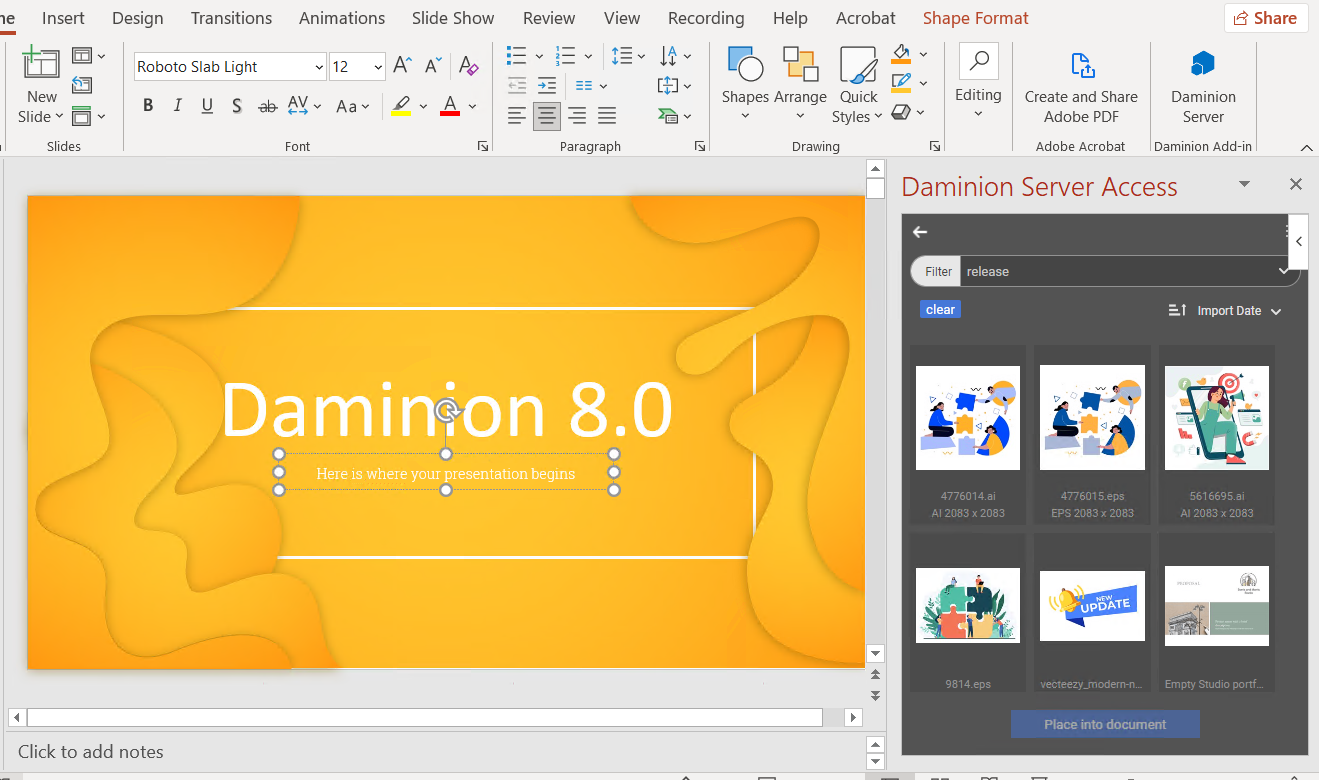Images play an important role in making PowerPoint presentations more visually appealing and engaging. However, large PowerPoint files with unoptimized pictures could be a serious issue when sending them over email or instant messaging services. They can hinder a mobile device’s performance, take forever to download on a poor connection, and use up unnecessary space.
Therefore, it is essential to optimize these photos for seamless and effective displays.
In this article, we’ll get into the ins and outs of image optimization in PowerPoint and detail how simple it is using DAM platforms like Daminion.
Optimizing Images in PowerPoint: Tips
Compress Images
To reduce file size without compromising quality, compress images in your presentation. Here’s how:
- Right-click on an image within your PowerPoint slide.
- Choose “Compress Pictures.”
- Select the desired resolution (lower resolution results in a smaller file size).
- Click “OK” to apply the changes.
Crop Images
Remove unnecessary elements from images by cropping them in PowerPoint. Follow these steps:
- Select the image you want to crop.
- Click “Picture Format” in the PowerPoint toolbar.
- Choose “Crop.”
- Adjust the cropping handles to remove unwanted parts of the image.
- Press “Enter” or click outside the image to apply the crop.
Use Consistent Styles
Maintain a professional look in your presentation by using images with similar styles, colors, and themes. Consistency in visuals helps keep your audience focused and enhances the overall design of your presentation. Consider the following when selecting images:
- Stick to a specific color palette.
- Use images with similar artistic styles or subjects.
- Choose images with consistent lighting and composition.
Opt for Vector Graphics
When possible, use vector graphics (such as SVG files) to maintain image quality while scaling. Vector graphics are resolution-independent, meaning they can be resized without losing quality, unlike raster images (JPEG, PNG, etc.). This is especially useful for logos, icons, and illustrations.
Save Images in the Right Format
Choose the appropriate file format for your images to ensure the best balance between quality and file size. Consider these guidelines:
- Use PNG format for images with transparency or sharp edges (e.g., logos, icons).
- Use JPEG format for photos or images with complex colors and gradients.
- Avoid using BMP or TIFF formats, as they can result in large file sizes.
Adjust Image Brightness and Contrast
Enhance the visual impact of your images by adjusting their brightness and contrast. To do this in PowerPoint:
- Select the image you want to modify.
- Click “Picture Format” in the PowerPoint toolbar.
- Choose “Corrections.”
- Use the sliders for brightness and contrast to make adjustments, or select a preset option.
- Click “OK” to apply the changes.
Remove Image Backgrounds
For a clean and professional look, remove the background from images. PowerPoint has a built-in feature to help you do this:
- Select the image with the background you want to remove.
- Click “Picture Format” in the PowerPoint toolbar.
- Choose “Remove Background.”
- Adjust the selection handles to keep the desired parts of the image.
- Click “Keep Changes” to apply the background removal.
Use SmartArt to Enhance Images
Incorporate SmartArt to improve the visual presentation of your images, especially when displaying processes, hierarchies, or relationships. To create a SmartArt graphic:
- Click the “Insert” tab in the PowerPoint toolbar.
- Choose “SmartArt.”
- Select a SmartArt category and graphic that suits your needs.
- Click “OK” to insert the SmartArt graphic.
- Replace the placeholder text or images with your own content.
Apply Image Effects
Add visual interest to your images by applying effects, such as shadows, reflections, or bevels. To apply an effect in PowerPoint:
- Select the image you want to modify.
- Click “Picture Format” in the PowerPoint toolbar.
- Choose “Picture Effects.”
- Select the desired effect category and specific effect from the dropdown menu.
- Customize the effect options if needed.
Use Image Alt Text
Add alt text to your images to improve accessibility for individuals using screen readers. Alt text also provides context for your images if they fail to load. To add alt text to an image in PowerPoint:
- Right-click on the image.
- Choose “Edit Alt Text.”
- Type a concise description of the image in the Alt Text box.
- Close the Alt Text pane to save your changes.
By incorporating these additional tricks, you can further optimize images in your PowerPoint presentations, creating visually appealing and accessible content for your audience.
Digital Asset Management and Daminion
Digital Asset Management (DAM) tools help organize, store, and manage digital assets, including images. Daminion is a popular DAM software that offers many benefits for image optimization in PowerPoint presentations. Some advantages of using Daminion include:
- Easy Integration with PowerPoint: Daminion’s seamless integration with PowerPoint simplifies the process of importing and managing images within presentations.
- Centralized Asset Management: Store and manage all your digital assets in a single location, making it easier to find and use the right images.
- Version Control: Daminion’s version control feature allows you to track changes and revert to previous versions if needed.
- Enhanced Collaboration: Multiple users can access and work on digital assets, streamlining the workflow for teams.
Daminion in Action
Daminion has been utilized successfully by companies in fields such as marketing, design, and education to optimize images in PowerPoint presentations.
Presentations created by a marketing group, for instance, can be more interesting, compact in terms of file size, and visually appealing.
Because enormous photographs and large file sizes of presentation are one challenge, but spending hours to discover the suitable images is another, DAM systems like Daminion will empower and speed-up this process.
A Step-by-Step Guide to Adding Daminion to PowerPoint
PowerPoint can be used to add Daminion in two ways:
1. Connecting with a Daminion Connector. Use the Connector’s search and filter features to find the files you need quickly and easily. Then, with just one click, you can add them to your documents, spreadsheets, and slideshows. Large pictures will be put in at a size that works best for shows.

Conclusion
Image optimization in PowerPoint is critical to ensure that your presentation is delivered and opened on any device, platform, or user.
Unfortunately, PowerPoint’s built-in picture optimization is restricted and time intensive. Especially if the number of presentations each month is not limited to 1-2 per month.
The use of DAM systems such as Daminion makes it easier to do this work. You will ensure that just the correct version of a picture is included into the Presentation, and that it is in the correct optimized image resolution, format, and size.
Aside from that, the entire process of locating the appropriate photos and accessing your presentation files will be significantly faster. Particularly if you work in a group.






